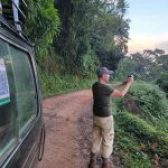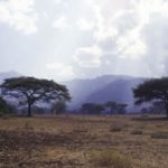Extending over more than 300km squared, the Mabira Forest Reserve, which straddles the Kampala-Jinja road about 20km west of Jinja, is primarily composed of moist semi-deciduous forest, in which more than 200 tree species have been identified. Mabira is one of the few ecotourism sites in Uganda. It is most visited by tourists taking safaris in Eastern Uganda and it is a convenient stopover for tourists exploring Jinja and Mount Elgon National Park.
The forest is interspersed with patches of open grassland, while several of the valleys support extensive papyrus swamps. In the colonial era, Mabira was heavily exploited for timber and rubber while its proximity to Kampala and Jinja led to an estimated 1,500tons of charcoal being extracted annually in the 1960s. During the civil war of the early 1980s, roughly 25% of the forest was cleared or degraded by subsistence farmers, who were evicted in 1988. Since then, much of the degraded forest has recovered through the replanting of indigenous trees, and illegal felling has practically ceased.
Mabira is by far the largest remaining stand of indigenous forest in central Uganda, not only of immense ecological valvue, but also situated so close to the country’s two largest cities offering great potential for recreation and tourist development. Certainly, the combination of accessibility, affordable accommodation, good monkey viewing and lovely walking trails makes it a highly recommended stopover for any traveller with an interest in natural history. Large mammals are relatively scarce today, though a small population of elephants was present as recently as the 1950s. The Red-tailed monkey is regularly seen in the vicinity of the camp, however, and grey-cheeked mangabey and blue duiker are quite common. Leopards are reputedly present but unlikely to be seen. More than 200 species of butterflies have been identified from Mabira.
Mabira ranks as one of the most important ornithological sites in Uganda, with more than 300 (mostly forest-associated) species recorded, including several rarities. The excellent network of forest trails that emanates from the visitor’s centre can be explored unaccompanied, but you will benefit greatly from taking a guide, whose knowledge of bird calls will assist in locating more elusive forest species. Conspicuous larger birds include the stunning great blue turaco and more familiar Africa where the pretty tit hylia has been recorded, and this rare bird is seen here with surprising regularity. It is also one of the few places in Uganda where the localized forest wood-hoopoe, African pitta, purple-throated cuckoo-shrike, leaflove, Weyn’s weaver and Nahan’s francolin are regular. Note, however, that the forest’s reputation as a good place to see the rare blue swallow is based on one vagrant sighting many years ago. One of the best individual birding sites at Mabira is a forest-fringed pond that can be reached by following the Jinja Road east for 5km past Najjambe, then turning left on to a small dirt road for a few hundred metres.
‘Mabira’ is a Luganda word literally meaning ‘large forest’, and the first European survey of the area referred to it as Mabira Nakalanga: the largest forests of Nakalanga, the latter being the name of the mischievous spirit said to inhabit it. According to folklore, Nakalanga is associated with one specific stream that runs through Mabira, the source of which was until recent times the site of an important sacrificial shrine consisting of several huts. Several early colonial writers reported that Mabira haboured a pygmy tribe called the Banakalanga (people of Nakalanga) and assumed that it was related to the Batwa Pygmies of the Congolese border area. Local Luganda legend, however, doesn’t regard the Banakalanga as a tribe, but rather as sports of nature. The belief is that the forest spirit punishes families that have fallen out of favour by cursing one of its children to be a puny and often mildly deformed dwarf.
In the 1950s, Rapper and Ladkin of the Uganda Medical Service investigated the Nakalanga and determined that they did indeed appear to be born randomly to physiologically normal parents with other healthy offspring. They concluded that the Banakalanga were affected by a form of infantilism linked to a pituitary defect, one that generally first showed itself when the afflicted person was about three years of age. The disease, Rapper and Ladkin believed, was pathological rather than genetic in origin, but its precise cause was indeterminate, as was its apparent restriction to one small area around Mabira Forest. Subsequent studies confirmed that Nakalanga dwarfism is a complication of a pituitary malfunction caused by onchocerciasis (a disease spread by the simulium blackfly) and note that the condition also occurs in Kabarole District of western Uganda. Interestingly, the first written references to the Banakalanga interchangeably calls them the Bateemba (people of the nests), evidently in reference to a hunting method used by pygmoid peoples elsewhere in Africa. Furthermore, Rapper and Ladkin record that a local Saza chief in the early 20th century had stated that a race of true Pygmies did once live in the forest, but some time before Europeans arrived in the area. It seems probable, then, that both Nakalanga and the medical condition attributed to the spirit’s mischief-making derive their name from that of a pygmoid tribe which once inhabited Mabira Forest.



